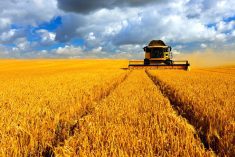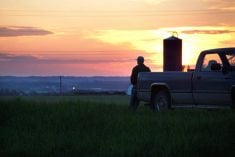For the Waddells, it’s been a challenge to convert financial ratios into strategies and action plans. It’s also been more than worth it
You’ve got to have profit,” says Charlie Waddell, owner of Waddell Apples near Kingston, Ont. “Whether you’re a smaller farm or a larger one, you need profitability for growth and stability.”
Like a growing number of Canadians, the Waddells are second-career farmers. Which means they aren’t hobby farmers. The Waddells want and need to make their farm pay, but they’ve also had to build up off-farm income to get their start. In fact, they’ll also need some off-farm income to keep it going, at least in short to mid-term.
Read Also

Producers aren’t panicking over tariffs and trade threats
The influence of tariff and trade uncertainity on farm business decisions.
Nor do they ever plan to farm the whole township. Instead, by working from a mid-size base, their challenge is to maximize their farm’s income potential so they can both work full-time on the farm.
It’s a challenge crying out for a plan. Planning for profit has been an integral part of farming for Charlie and his business partner and wife Marita. In 2003, the Waddells bought a 13.5-acre orchard north of Kingston and started their second career, doing what they both grew up doing in southern Quebec, growing and selling apples.
“I’ve been working with my dad all along and never really left it,” says Charlie, although as a commercial enterprise, the original family orchard was badly damaged by ice storms and then further hurt by changing markets.
The Waddells chose their Kingston site because it included a good location close to the city and it already had a small clientele base. They saw potential. With the lessons they had learned on their parents’ farms and in the workforce, they believed they had a good shot at developing a profitable farm, based on two key strategies: rigorous financial planning, and selling directly to the customer.
Six years later, they’ve more than doubled gross revenues from the farm
Photo credit: Wayne Hiebert
during a time when the wholesale apple business has been difficult. They’ve added pick-your-own and they rebuilt an 1830’s log house and converted it into a store that they have stocked with a focus on value adding, including a bakery, preserves and, more recently, local honey and maple syrup.
Right from the beginning, the Waddells made it their goal to increase the percentage of retail apples their orchard produced. By changing harvesting techniques, they’ve flipped the ratio of windfalls to #1 grades from 60:40 to 40:60 in five years. “Our verbal goal to each other is to reach an 80:20 ratio,” says Charlie.
The Waddells stated their goal, developed a plan and worked hard to make it happen. This is how they approach their business with planning sessions at least twice a year. After the fall, they review profitability and talk about new projects. During the winter they prioritize reinvestments, depending on profits for the year and research logistics. Then, they roll up their sleeves and get at it.
“We’re natural planners” says Marita. “Charlie and I are always talking about what we’re going to do.”
Planning sessions twice a year
A couple of government programs helped the Waddells do some formal planning. In 2005, they took advantage of the federal Farm Business Assessment grants and hired a chartered accountant to help them with some goal setting, a business review and setting action plans.
“It was an interactive process,” says Marita. “We spent probably half a day gathering information and then we had homework. Some things were eye opening.” For example, the accountant made them understand the basic cost of their lifestyle and showed how having an off-farm income was helping them.
If you start adding up all your household expenses, Marita now says, it’s astounding, especially if you have children in competitive sports, college or university. For most people, the lifestyle ratio is from $40,000 to $70,000 per adult family including housing, utilities, groceries, insurance, commuting expenses. One key job, she says, is to plan what their farm contributes to those expenses.
Marita separates net revenues between enterprises so she and Charlie can compare and make good business decisions.
bakery, orchard, pick-your-own and store divisions, they can calculate the payback for investment and labour for each enterprise. Plus, they can also project returns on investment, so they can decide where they should invest to make the greatest year-over-year and longer term differences.
Their financial adviser calculated some ratios and helped them create an action plan. For the Waddells understanding the financial ratios and really using these numbers to establish business strategies is the most difficult part of the process. “It’s one thing to have the ratios and know how they work but it’s another to believe those numbers,” says Charlie.
It’s only been four years and already they’ve met most of their goals. They have increased their gross sales of apples, added new enterprises, improved retail operations, developed a website, and brought on new value-added products. The U-pick sales now equal the ready-picked sales and they’ve reduced the proportion of wholesale apples sales.
The previous owners sold ready-pick only. Charlie grew up on a large U-pick orchard and had watched the popularity of it decline since the 1980s. Luckily, the recent local food movement has meant an upsurge in U-pick customers.
One goal they haven’t reached is to write a formal business plan. “We want
bakery, orchard, pick-your-own and store divisions, they can calculate the payback for investment and labour for each enterprise. Plus, they can also project returns on investment, so they can decide where they should invest to make the greatest year-over-year and longer term differences.
Their financial adviser calculated some ratios and helped them create an action plan. For the Waddells understanding the financial ratios and really using these numbers to establish business strategies is the most difficult part of the process. “It’s one thing to have the ratios and know how they work but it’s another to believe those numbers,” says Charlie.
It’s only been four years and already they’ve met most of their goals. They have increased their gross sales of apples, added new enterprises, improved retail operations, developed a website, and brought on new value-added products. The U-pick sales now equal the ready-picked sales and they’ve reduced the proportion of wholesale apples sales.
The previous owners sold ready-pick only. Charlie grew up on a large U-pick orchard and had watched the popularity of it decline since the 1980s. Luckily, the recent local food movement has meant an upsurge in U-pick customers.
One goal they haven’t reached is to write a formal business plan. “We want














